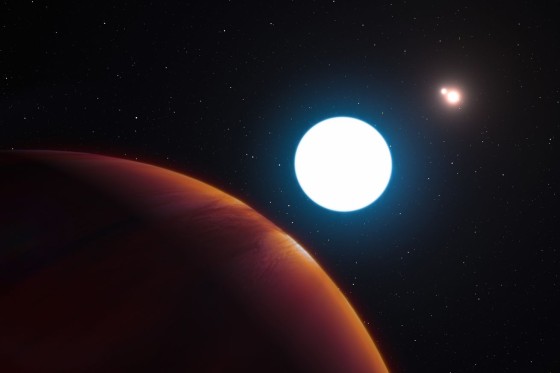Massive Planet found within a triple-star system. Take that, Binary Sunset
Space, man. Constantly taking our notions of what’s possible, farting on them loudly, and then ripping them up and throwing them into the wind. Planet without a triple-star system? Impossible! Except. Not.
More than 340 light years away, a giant planet is trapped in a dance with three stars. It’s a unique world, where suns rise and set three times a day, and where one year lasts more than half a millennium. It’s so bizarre that the existence of such a place was thought to be impossible — but astronomers have captured a rare, direct picture of this exotic domain.
Using the Very Large Telescope in northern Chile, researchers have directly imaged this planet — named HD 131399Ab — within a triple-star system, according to a new study published today in Science. It’s a feat that’s incredibly difficult to do. Multi-star systems are super bright, so much so that they often drown out any planets orbiting nearby, making them hard to spot.
“It’s definitely one of the hardest observations you can do in modern astronomy,” study author Kevin Wagner, a first-year PhD student at the University of Arizona and the person who discovered HD 131399Ab, told The Verge. But by using a combination of advanced optical techniques, the astronomers were able to observe this planet in the near-infrared. That makes it just one of a handful of exoplanets — or planets located outside our Solar System — to be imaged directly.
That imaging paints a picture of a fairly unique world. HD 131399Ab is thought to be a gas giant, about four times the mass of Jupiter, with water and methane in its atmosphere. And its orbit is astonishing to the researchers. It travels around one of the stars in the system at a distance that’s about twice that of the Sun and Pluto, an incredibly wide orbit that lasts 550 Earth-years. For most of that time, the planet has a routine daytime and nighttime, as the three suns rise and set close together. But as the planet moves throughout the system, there comes a time when one sun rises just as another sets. This leads to a period where HD 131399Ab is bathed in constant sunlight — an interval that lasts 140 years.
It’s a scenario that’s never been seen before. Researchers suspected it was nearly impossible for a planet to have that wide of an orbit in a three-star system. It was thought that such a planet would be unstable, and that the gravity from the other stars would throw the planet off course and even eject it from the system entirely. But today’s study reveals that such a set-up can actually exist, opening up the possibility that other similar systems exist elsewhere in the Universe. “That would have seemed like science fiction to us in the past,” said Wagner.




